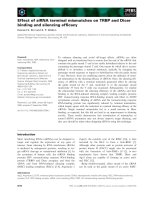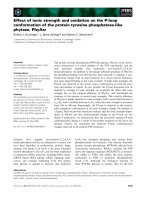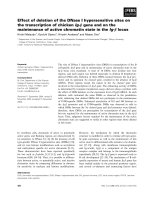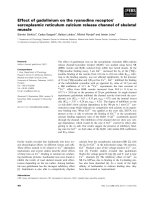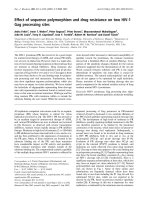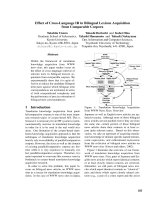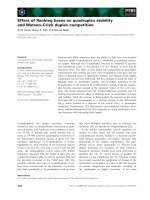Báo cáo khoa học: "Effect of intern’s consecutive work hours on safety, medical education and professionalism"
Bạn đang xem bản rút gọn của tài liệu. Xem và tải ngay bản đầy đủ của tài liệu tại đây (33.97 KB, 3 trang )
528
ACGME = Accreditation Council for Graduate Medical Education.
Critical Care October 2005 Vol 9 No 5 Landrigan et al.
We would like to thank Dr Sarani and Dr Alarcon for their
critique of our work, published online in Critical Care on 12
January 2005 [1]. We have reviewed the critique, and in
general we think that it appropriately describes both the
strengths and limitations of our studies.
We would like to make a few minor factual clarifications. First,
although the study by Lockley and colleagues used a within-
subjects analytical design [2], the study by Landrigan and
colleagues did not [3]. A systemic-level approach rather than
a within-subjects analysis was used in comparing interns’
serious medical error rates, making these analyses
comparable with analyses of errors system wide (i.e. those
that involved both interns and other personnel), where a
within-subjects design was not appropriate. Data from 20
interns were analyzed in Lockley and colleagues’ study, as
the authors note; however, data from an additional four
interns contributed to the analysis in the study by Landrigan
and colleagues. Our power to detect a 16% difference in
serious medical errors was calculated to be 80%, not 90%.
In addition, there is one error in the description of the
limitations that we would like to point out. Dr Sarani and Dr
Alarcon note:
“There were more patients admitted to the ICU and more ICU
patient-days in the traditional arm than in the intervention arm.
Although these differences were not statistically significant, it
does raise the possibility that interns in the traditional arm
had more opportunities to make serious errors.”
Differences in the incidence of serious errors were analyzed
using rates (per patient-day), and therefore the fact that there
were more patient-days in the traditional schedule cannot
explain the results. On a per patient-day basis, there were no
more opportunities to err in the traditional schedule. This is
further confirmed by the fact that there were no more
medications ordered or diagnostic tests interpreted in the
traditional schedule per patient-day, and there were in fact
fewer procedures performed in the traditional schedule per
patient-day.
With respect to the recommendations following from our
findings, we strongly disagree with Dr Sarani and Dr Alarcon’s
statement that our study supports the Accreditation Council for
Graduate Medical Education (ACGME) duty-hour standards:
“Based on the results of these studies, it seems that the
ACGME resident work hour restrictions are warranted, at
least for interns, and that efforts to reduce the number of
hours worked by interns may improve patient care.”
Although we would agree that efforts to reduce the number
of hours worked by interns may improve patient care, our
traditional schedule was in fact compliant with the ACGME
duty-hour standards. In effect, we were comparing these
standards with a schedule that much more substantially
reduced continuous working hours than the ACGME
regulations demand, with a maximum of 16 scheduled
consecutive hours. Our data support an extensive literature,
derived from laboratory and field studies in other safety-
sensitive industries, that 24 hours or more consecutive work
are unsafe. Efforts to reduce work hours should focus first
and foremost not on the frequency of extended-duration work
shifts, but on the duration of consecutive work hours during
such shifts. Research from laboratory and industrial settings
suggests that performance deteriorates rapidly and the
propensity to err rapidly increases after 16 hours of sustained
wakefulness, a finding reflected in the twofold increase in
interns’ attentional failures after they had been working for
more than 16 hours on the traditional schedule [2].
Letter
Effect of intern’s consecutive work hours on safety, medical
education and professionalism
Christopher P Landrigan, Steven W Lockley and Charles A Czeisler
Division of Sleep Medicine, Boston, Massachusetts, USA
Corresponding author: Christopher P Landrigan,
Published online: 24 May 2005 Critical Care 2005, 9:528-530 (DOI 10.1186/cc3730)
This article is online at />© 2005 BioMed Central Ltd
See related Journal club critique, />529
Available online />We agree with the recommendation that further research
should study the effects of sleep deprivation and work
schedule interventions on the performance of upper-level
residents and other medical staff across a variety of
disciplines. We likewise agree that optimizing patient hand-
offs, medical education, and trainees’ sense of
professionalism should be priorities as interventions are
developed that reduce consecutive work hours to ensure the
safety of patient care. We believe, however, that development
of ‘a sense of professionalism’ is not a function of whether a
shift is 30 hours or is 16 hours, but is a function of the ethical
priorities engendered through the medical training process;
first among these is the moral obligation to ‘Do No Harm’.
Carefully controlled studies of our own systems and practices
are essential to determine how best to protect patients and,
ultimately, the integrity of our profession.
With respect to medical education, it is important to
recognize that sleep deprivation has been found to adversely
affect education as well as resident and patient safety.
Recent work has demonstrated markedly impaired learning
among research subjects deprived of sleep [4-6]. Whether
residents exposed to recurrent acute sleep deprivation learn
more or learn less than better-rested residents who spend
fewer hours in the hospital remains to be tested, and should
be a major focus of future work.
Authors’ response
Eric B Milbrandt, Babak Sarani and Louis H Alarcon
We would like to thank Dr Landrigan, Dr Lockley, and Dr
Czeisler for their comments, including clarification of the
power, sample size, and statistical approach descriptions that
appeared in our recent Journal Club review [1] of their
studies examining the effect of reducing interns work hours in
the intensive care unit [2,3].
Our statement that “interns in the traditional arm may have
had more opportunities to make serious errors” was based on
the incorrect assumption that the total number of days in
each schedule was the same. Under this assumption, the
observation that there were more admissions and patient-
days, yet the same number of interns, in the traditional arm
would have meant that each intern admitted and cared for
more patients. In other words, each intern would have had a
heavier workload and, therefore, more opportunities to make
errors. As Landrigan and colleagues correctly point out, this
could not have accounted for the error differences they
observed, because these data were presented as rates
(errors/1000 patient-days). That the rates of medication
orders and test interpretations did not differ between groups
certainly suggests that the overall workload was the same in
each group. However, the intensity of orders, procedures,
and diagnostic interpretations is likely to be greatest at the
time of intensive care unit admission. If interns did admit more
patients in the traditional arm, there may have been more
opportunities for each intern to err, even though this would
not have been reflected in the overall observed rates. To
clarify this, perhaps the authors could have presented
summary measures for the number of patients admitted and
cared for by interns in each study arm.
We stated that “based on the results of these studies, it
seems that the ACGME resident work hour restrictions are
warranted”, when instead we should have said “resident work
hour restrictions in general are warranted”. Indeed, the
results of these studies do suggest that the ACGME did not
go far enough. But how far is enough and at what point do
the increased errors associated with more frequent hand-offs
offset the reduced errors associated with better-rested care
providers? As noted by the authors, their intervention took
place in a system that was designed to minimize the impact
of hand-offs, which by definition occurred more frequently in
the intervention schedule. Even with this special attention to
hand-offs, at least one physician who attended the intensive
care unit during the studies noted that interns in the
intervention schedule “often knew very little about the
patients who had been admitted the night before” and that
the “intern coming on at 9 p.m. … had not considered the
patient as one of his or her cases” [7]. If these studies had
been conducted without extra attention to this important
transition in care, perhaps the results would have been
different, as other studies have suggested [8,9].
Despite these relatively minor limitations, these two studies
offer the best evidence to date that sleepy interns provide
bad patient care, and we applaud the authors for their
excellent work. We reiterate that as we move to more
restricted resident work hours, it will be crucial that we instill
a sense of professionalism in our trainees, such that
commitment to individual patients does not wane as work
hours are curtailed and that a ‘shift-work’ mentality does not
compromise care.
Competing interests
CAC was paid an honorarium to deliver a plenary address for
an annual educational conference of the ACGME.
530
Critical Care October 2005 Vol 9 No 5 Landrigan et al.
References
1. Sarani B, Alarcon LH: Journal club critique: Reducing interns’
work hours led to fewer attentional failures and serious
medical errors in intensive care units. Crit Care 2005, 9:E3.
2. Lockley SW, Cronin JW, Evans EE, Cade BE, Lee CJ, Landrigan
CP, Rothschild JM, Katz JT, Lilly CM, Stone PH, et al.: Effect of
reducing interns’ weekly work hours on sleep and attentional
failures. N Engl J Med 2004, 351:1829-1837.
3. Landrigan CP, Rothschild JM, Cronin JW, Kaushal R, Burdick E,
Katz JT, Lilly CM, Stone PH, Lockley SW, Bates DW, Czeisler CA:
Effect of reducing interns’ work hours on serious medical
errors in intensive care units. N Engl J Med 2004, 351:1838-
1848.
4. Stickgold R, James L, Hobson JA: Visual discrimination learning
requires sleep after training. Nat Neurosci 2000, 3:1237-1238.
5. Walker MP, Brakefield T, Morgan A, Hobson JA, Stickgold R:
Practice with sleep makes perfect: sleep-dependent motor
skill learning. Neuron 2002, 35:205-211.
6. Walker MP, Stickgold R: Sleep-dependent learning and
memory consolidation. Neuron 2004, 44:121-133.
7. Drazen JM: Awake and informed. N Engl J Med 2004,
351:1884.
8. Laine C, Goldman L, Soukup JR, Hayes JG: The impact of a reg-
ulation restricting medical house staff working hours on the
quality of patient care. JAMA 1993, 269:374-378.
9. Petersen LA, Brennan TA, O’Neil AC, Cook EF, Lee TH: Does
housestaff discontinuity of care increase the risk for pre-
ventable adverse events? Ann Intern Med 1994, 121:866-872.


